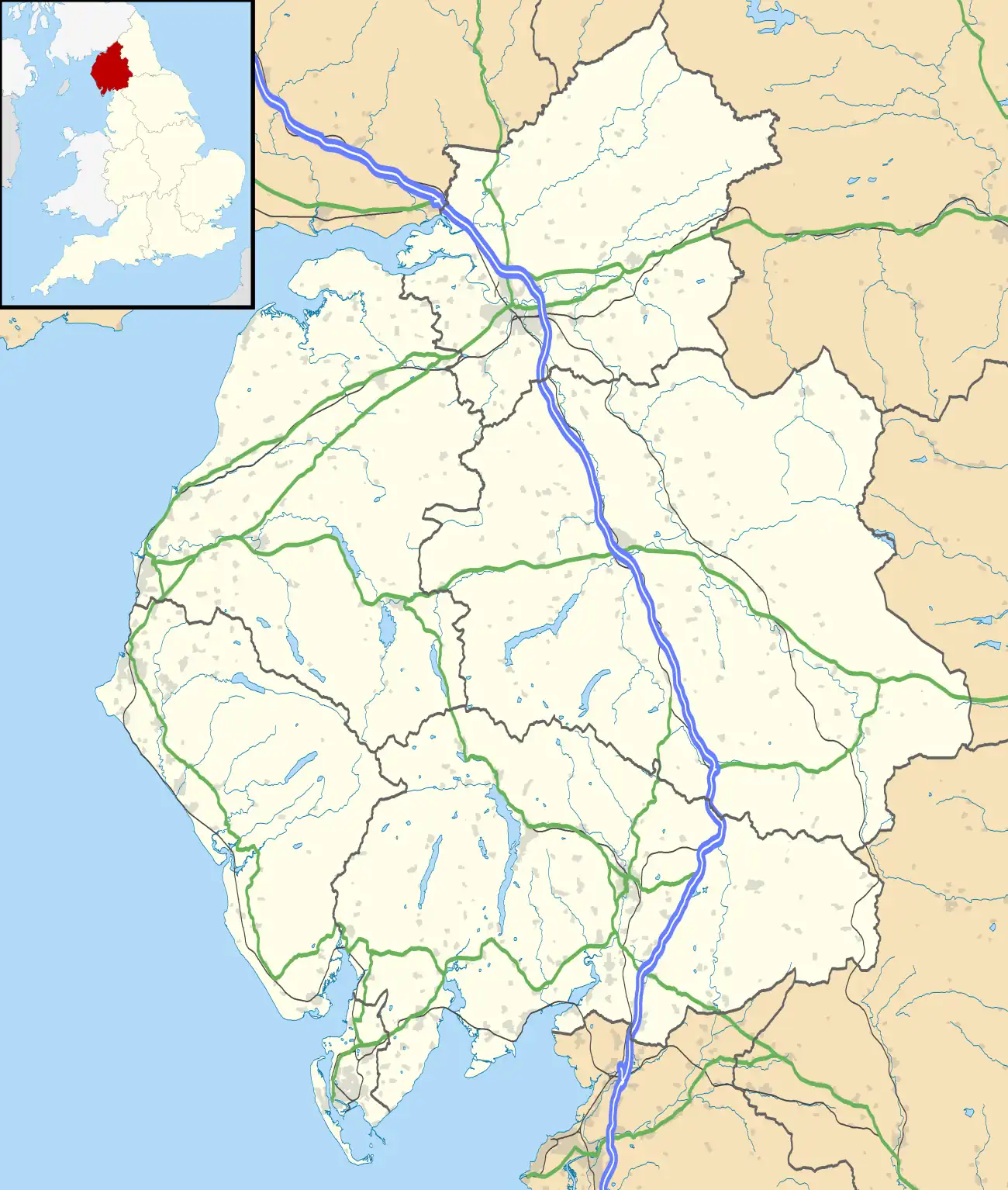| Hawkshead | |
|---|---|
 Ann Tyson's House | |
 Hawkshead Location within Cumbria | |
| Population | 519 (2011 census)[1] |
| OS grid reference | SD3598 |
| Civil parish |
|
| Unitary authority | |
| Ceremonial county | |
| Region | |
| Country | England |
| Sovereign state | United Kingdom |
| Post town | AMBLESIDE |
| Postcode district | LA22 |
| Dialling code | 015394 |
| Police | Cumbria |
| Fire | Cumbria |
| Ambulance | North West |
| UK Parliament | |
| Website | |
Hawkshead is a village and civil parish in Westmorland and Furness, Cumbria, England. Within the boundaries of the historic county of Lancashire, the parish includes the hamlets of Hawkshead Hill, 1.2 miles (1.9 km) to the north west, and Outgate, a similar distance north. Hawkshead contains one primary school but no secondary school and four public houses.
Geography

Hawkshead is just north of Esthwaite Water, in a valley to the west of Windermere and east of Coniston Water. It is part of Furness, making it a part of the ancient county of Lancashire.[2]
History
The township of Hawkshead was originally owned by the monks of Furness Abbey; nearby Colthouse derives its name from the stables owned by the Abbey. Hawkshead grew to be an important wool market in medieval times and later as a market town after the Dissolution of the Monasteries in 1532. It was granted its first market charter by King James I in 1608. In 1585, Hawkshead Grammar School was established by Archbishop Edwin Sandys of York after he successfully petitioned Queen Elizabeth I for a charter to establish a governing body.[3]
In the 18th and 19th centuries, Hawkshead became a village of local importance. Hawkshead Market Hall was completed in 1790.[4]
William Wordsworth (afterwards poet laureate) was educated at Hawkshead Grammar School, whilst Beatrix Potter lived nearby as did William Heelis, a local solicitor, in the early 20th century.[5]
With the formation of the Lake District National Park in 1951, tourism grew in importance, though traditional farming still goes on around the village. Hawkshead has a timeless atmosphere and consists of a characterful warren of alleys, overhanging gables and a series of mediaeval squares. It is eloquently described in William Wordsworth's poem The Prelude.[6]
Much of the land in and around the village is now owned by the National Trust. The National Trust property is called Hawkshead and Claife.[7]
Governance
Hawkshead is part of the electoral ward of Coniston and Hawkshead in the Westmorland and Furness Council area.[8]
Parliamentary representation
Hawkshead is part of the Westmorland and Lonsdale parliamentary constituency and is represented in parliament by Tim Farron MP.[9]
See also
References
- ↑ UK Census (2011). "Local Area Report – Hawkshead Parish (E04002610)". Nomis. Office for National Statistics. Retrieved 30 March 2019.
- ↑ Wilson, John Marius (1872). "Hawkshead". Imperial Gazetteer of England and Wales.
- ↑ Historic England. "Hawkshead Grammar School (1087232)". National Heritage List for England. Retrieved 19 January 2017.
- ↑ Historic England. "Hawkshead Market Hall and Market Hall Cottage (1121554)". National Heritage List for England. Retrieved 25 April 2022.
- ↑ "Beatrix Potter, the Lake District and the National Trust". National Trust. Retrieved 25 April 2022.
- ↑ Wordsworth, William (1850). The Prelude or, Growth of a Poet's Mind; An Autobiographical Poem (1 ed.). London: Edward Moxon, Dover Street. Retrieved 16 June 2016 – via Internet Archive.
- ↑ "Windermere west shore walk". National Trust. Retrieved 25 April 2022.
- ↑ "Westmorland and Furness Council wards map" (PDF).
- ↑ "Tim Farron MP". Parliament.uk. Retrieved 30 March 2019.
External links
- Cumbria County History Trust: Hawkshead and Monk Coniston with Skelwith (nb: provisional research only – see Talk page)
- Official Hawkshead website
- Beatrix Potter Gallery and Hawkshead information at the National Trust
- Hawkshead in an Illustrated guide to the Lake District
- Hawkshead Grammar School Museum
- Photographs of Hawkshead
- The Benefice of Hawkshead with Low Wray and Sawrey and Rusland and Satterthwaite
